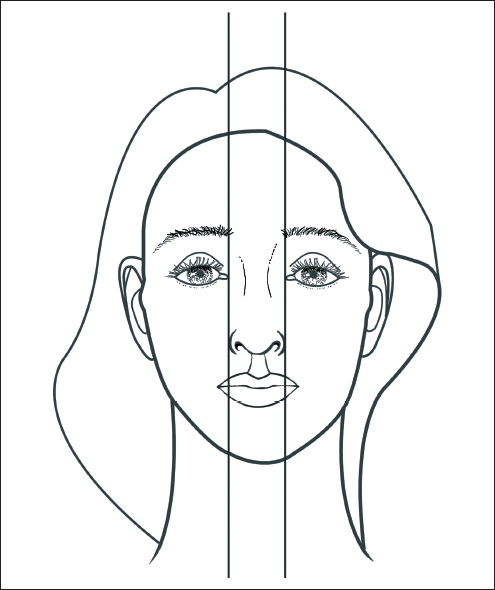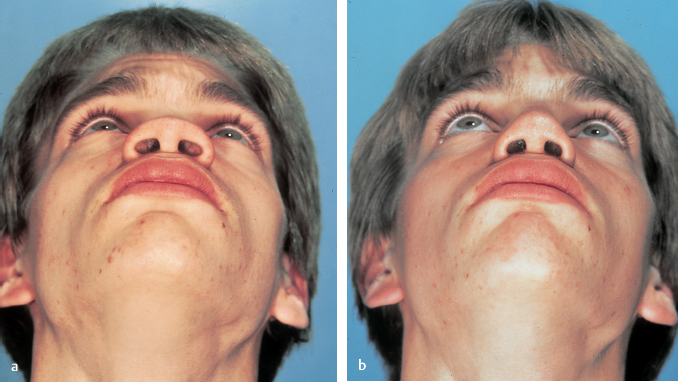Chapter 9 Modification of the alar base and lobule anatomy during rhinoplasty by various forms of alar reduction, repositioning, reorientation, or sculpturing assists in balancing the final appearance of the nose. Aesthetic narrowing of the nasal skeleton and tip must, in selected patients, be balanced by concomitant reduction refinement of the alar base (usually as the final step in the operation), else the nose appears “bottom-heavy” and disproportionate. Classically, a vertical line dropped from each inner canthus alongside the nose should define, in most ethnic types, the lateral limits of the alae for an ideal normal appearance on frontal view (Fig. 9.1). Wider or more flaring alae suggest consideration for alar base reduction techniques (Fig. 9.2). These, like nasal tip sculpture techniques, are best executed in a graduated fashion, planned entirely upon the individual anatomy encountered and the aesthetic appearance desired. In most retropositioning tip techniques employed to correct the overprojected nose, lateral flaring of the alar sidewalls results, inviting alar reduction in both width and overall alar sidewall length. Weir is credited with the first published reference to alar base narrowing.1 Thus, alar base narrowing is traditionally referred to by surgeons as the “Weir procedure”; we prefer the term “alar base reduction,” since the exact procedure recommended by Weir is indistinct. His seminal article fails to illustrate the exact technique recommended. Others throughout the 20th century, however, have refined precise indications for and techniques of alar base reduction and narrowing during rhinoplasty. The exact alar reduction technique chosen will be dependent upon the individual anatomy encountered, the aesthetic outcome desired, and the need to camouflage resultant epithelial scars. Alar modifications are rather consistently required to balance the nasal anatomy in certain ethnic anatomical types (i.e., black, Asian, oriental, and mestizo noses), while the need to perform alar reduction in the more typical Caucasian nose is less frequent. Nonetheless, alar base modifications are indicated when alar flaring, bulbosity, or excessive width of the nasal base are present, or when retropositioning of excessive tip projection results in a displeasing postoperative alar flare on the operating table. An excessively wide nostril floor dimension may also dictate the need for alar sill or nostril floor modifications. If preoperative asymmetry exists (as in the cleft lip/nose complex anomaly), alar modification should be considered. Fig. 9.1 In faces with normal proportions, an imaginary line dropped from the inner canthi defines the normal width of the nasal alar base. Fig. 9.2 (a) Unusually wide nasal base, significantly narrowed with a sliding alar flap procedure combined with improvement of tip projection (b). Alar reduction of any type must be carried out in a conservative and symmetrical manner, lest one deformity be substituted for another. Even subtle or minimal asymmetries or over-reductions may create a major deformity where only a minor balance abnormality preexisted. If overaggressive resection of the alar base occurs, correction is difficult. In addition, it is important that the surgeon bring all his skills into play in the effort to minimize and camouflage the resultant alar scars, which can draw unwanted attention to an otherwise excellent rhinoplasty outcome. In revision rhinoplasty, alar base reduction or modification is indicated if a widened or asymmetrical alar base exists. Similarly, poor or visible scars resultant from primary alar base reduction deserve improvement and camouflage. Only relative contraindications exist for alar base reduction surgery. Infantile nostrils, even in patients with a widened alar base disproportion, should not be rendered to an unacceptably smaller dimension by alar reduction. Overly small nostril openings resultant from previous surgery should not be made unacceptably small by attempts to camouflage unsightly alar lobule or nostril sill scars. Alar reduction of major magnitude should be contemplated with caution when revision open rhinoplasty is carried out. Compromised blood supply to the tip has been reported in a few patients in this category. Internal buried alar cinch suture techniques can narrow the alar base modestly, but generally at the expense of alar base tissue distortion and possible asymmetry. Moreover, long-term continuous tension created by permanent suture cinching is always subject to eventual suture tear-out and failure. Precision surgical alar excision and repair remains the more acceptable surgical choice. Thorough informed consent is essential before alar reduction is contemplated. Patients must understand that bilateral alar–facial junction scars will be present (although generally nicely camouflaged). If available, preoperative computer imaging can assist in confirming for the patient the benefit of surgical alar base reduction. Standard five-view rhinoplasty photographic documentation is essential, with the close-up basal view most helpful. The following is a list of special surgical requirements: 1. Fast-absorbing catgut suture: 5–0. 2. Polydioxanone suture: 5–0. 3. Needlepoint microcautery. 4. Histacryl Blue or Dermabond tissue glue. 5. A 15C Bard-Parker knife blade. 6. Surgical measuring calipers. Nothing equals the importance of extremely accurate and precise preoperative analysis and diagnosis in planning alar reduction surgery. The frontal and base views play the most important role in preoperative evaluation. A vertical line dropped from each inner canthus helps to define the aesthetic appropriateness of alar base anatomy (Fig. 9.1). On base view, the same vertical lines from the inner canthus define the correct alar–facial junction (Fig. 9.3). If the alar lobules fall outside (lateral to) this vertical line, alar base reduction is generally indicated to avoid a postoperative “bottom-heavy” nasal appearance. The preferred terminology, desirable ideal normal anatomy, and preferred aesthetic relationships of the alae and nostrils to the face and nose are depicted in Fig. 9.4. In general, the alar lobule is composed of fibrofatty areolar tissues covered by epithelium both internally and externally (Fig. 9.5). Completely devoid of alar or sesamoid cartilage, the alae assume markedly different shapes, sizes, and configurations in different ethnic groups and even within similar ethnic groups (Fig. 9.6).2 In the typical Caucasian patient, the alar sidewalls serve as minor or adjunctive supportive mechanisms for the nasal tip, but if thin, delicate, and somewhat anatomically frail, they may contribute nothing to tip support and are in danger of potential eventual collapse if an overabundance of supportive alar cartilage is resected during tip sculpturing.
Alar Reduction and Sculpture
9 Alar Reduction and Sculpture
9.1 Introduction
9.2 Indications
9.3 Contraindications
9.4 Alternative Techniques
9.5 Preoperative Considerations
9.6 Special Surgical Requirements
9.7 Preoperative Analysis
Plastic Surgery Key
Fastest Plastic Surgery & Dermatology Insight Engine












